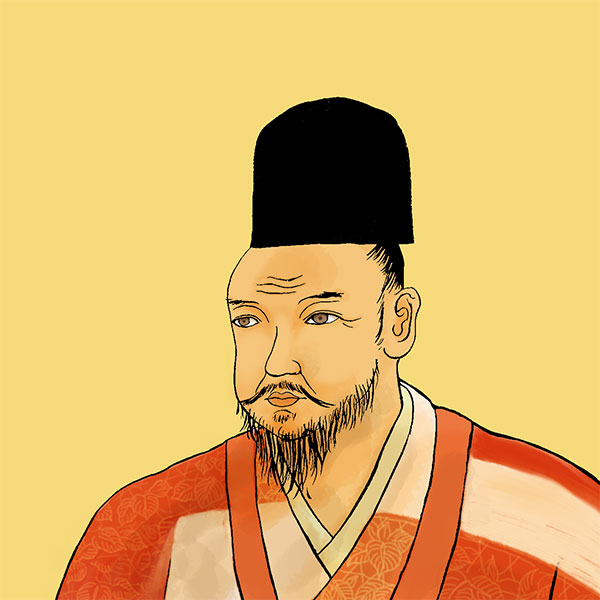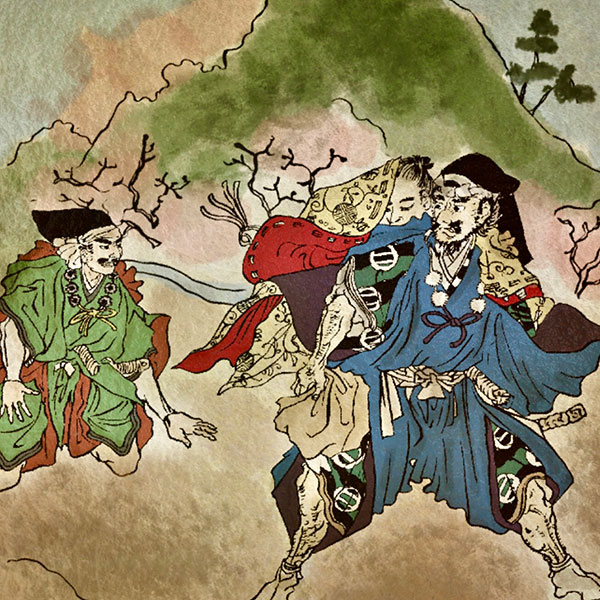Yoshiteru Ashikaga (1/2)The 13th shogun of the Muromachi shogunate, known as the master swordsman.

Yoshiteru Ashikaga
- Article category
- biography
- name
- Yoshiteru Ashikaga (1536-1565)
- place of birth
- Kyoto
- Related castles, temples and shrines

Nijo Castle
- related incident
After the Onin War, the authority of the Muromachi shogunate gradually declined. At the same time, powerful warlords and nationalists from various regions gradually gained power, and their power as shoguns began to decline. Meanwhile, Yoshiteru Ashikaga, who became the 13th shogun of the Muromachi shogunate, was swayed for better or worse by Nagayoshi Miyoshi and Hisashi Matsunaga, and in the end, it is said that he was cut to death or committed suicide, and he was so skilled that he was said to be a great swordsman. I was there. What kind of life did he lead?
From birth to becoming a general
Born on March 10, 1536, at Nanzenji Temple in Higashiyama, the eldest son of Yoshiharu Ashikaga, the 12th Shogun. His mother is Keijuin, the daughter of Naomichi Konoe. His childhood name was Kikudomaru.
It is said that Kikubaramaru was the first male child born to a shogun and his legal wife since Yoshihisa Ashikaga, and the first male member of the shogunate family whose mother was a woman from the Sekkan family.
Immediately after his birth, his father Yoshiharu asked Naomichi Konoe to adopt him, and Kikubaramaru became his adopted child. Naomichi was so happy to become the maternal grandfather of the future shogun that he wrote in his diary that Kikubaramaru's birth was ``the ultimate celebration.''
Around this time, in the shogunate, there was a conflict between his father Yoshiharu and Kanrei Harumoto Hosokawa, and Yoshiharu was defeated every time they fought and fled to Sakamoto, Omi Province, and Kikubaramaru often followed suit. Also, up until then, it was customary for the eldest son of a shogunate to be raised in the residence of the Ise clan, the head of government, but Kikubaramaru was raised in the care of his parents.
On July 27, 1546, Kikunamaru was given the title of Yoshifuji by the imperial court, and on November 19 of the same year, he was given the title Samadō, which the heirs of shoguns had been appointed to for generations. was appointed.
On December 19th of the same year, Yoshito's Genpuku ceremony was held at the shrine of Hiyoshi Shrine (currently Hiyoshi Taisha Shrine) in Omi Sakamoto, Shigeyasu Kishita, and the head of the Rokkaku clan, Sadayori Rokkaku, became the Eboshi parent.
It is said that Sadayori himself was ordered by Yoshiharu to become Eboshi no Oka, and although he refused many times, Yoshiharu would not allow him to decline.
The following day, on the 20th, a ceremony was held to declare him shogun, and Yoshifuji was given the title of shogun by his father at the age of only 11, and was officially appointed as the 13th shogun. At the end of the same month, Yoshifuji and his father, Yoshiharu, left Sakamoto and returned to Higashiyama Jishoji Temple in Kyoto. Immediately after that, Yoshito began his activities as a shogun.
Battle with Harumoto Hosokawa
His father, Yoshiharu, broke up with Harumoto Hosokawa, who was in a state of decline, and joined forces with Ujitsuna Hosokawa, but Harumoto did not remain silent either. In retaliation, Harumoto supported Yoshiharu's brother Yoshitsune Ashikaga, who had been sheltering him in Awa. Harumoto supported Yoshiharu until they broke up, but on the other hand, they had a ``twisted relationship'' in which he protected Yoshitsune.
However, this situation bothers Sadayori Rokkaku. For Sadayori, Yoshiharu was a comrade who had supported him along with Harumoto, and Yoshifuji was also a person for whom he had served as Eboshi-ya. On the other hand, Harumoto was also his son-in-law and was close to him, so if he sided with Harumoto, he would deny Yoshito's authority as a shogun and recognize Yoshitsune as the shogun. .
Therefore, Sadayori tries to reconcile the father and son Yoshiharu and Yoshifuji with Harumoto. Meanwhile, the relationship between Yoshiharu/Yoshifuji and Harumoto deteriorated, and Harumoto defeated the Ujitsuna faction in various places and approached Kyoto.
On March 29th, Yoshifuji and Yoshiharu, fearing for their lives, fled to Shogun Yamashiro, which they had built in Kitashirakawa, and holed up there. Then, as Sadayori became clear about his confrontational stance with Harumoto, he was caught between the two.
On July 12, Shogun Yamashiro, where Yoshifuji and Yoshiharu were holed up, was surrounded by the large army of Sadayori and Harumoto, and Sadayori forced the father and son to make peace with Harumoto. Due to Sadayori's betrayal, the father and son were left with no choice but to fully accept his demands.
In April 1995, Sadayori entered Yamato, met Nagayori Yusa of the Ujitsuna faction, and tried to reconcile the Harumoto faction and the Ujitsuna faction. As a result, the disturbances of the Hosokawa clan subsided, and the political situation in the Kinai region became stable. Therefore, on June 17th, Yoshifuji and Yoshiharu returned from Sakamoto to Kyoto and entered the Imadegawa Imperial Palace.
Battle with Nagayoshi Miyoshi
However, Nagayoshi Miyoshi, a vassal of Harumoto Hosokawa and the head of the Miyoshi clan, who was building a major power in the Kinai region, betrayed Harumoto and transferred to Ujitsuna Hosokawa's camp.
On June 24, 1549, Nagayoshi defeated Masanaga at Settsu Eguchi. As a result, Harumoto, who had supported Masanaga, was in a worse position, and on the 28th of the same month, Yoshifuji and Yoshiharu, accompanied by Harumoto, escaped from Kyoto with Konoe Konoe and Harumichi Kuga, and went to Omi Sakamoto, relying on Rokkaku Sadayori. Evacuate.
On July 19th, Nagayoshi went to Kyoto in honor of Ujitsuna. In order to deal a blow to Yoshito's side, Matsunaga Hisashi's younger brother, Matsunaga Nagayori (Naito Munekatsu), embezzled Yamashina Shichigo, claiming that it had been given to Ujitsuna.
Yoshiharu had the idea that he would be able to return to Tokyo immediately, but the battle between Harumoto and Nagayoshi seemed unlikely to be resolved, and Yoshiharu fell ill from the end of the same year, and by the New Year of the following year, Tenbun 19 (1550). However, it did not improve. Yoshito, thinking of returning to Kyoto as soon as possible for his father's sake, began preparations for a counterattack against the Miyoshi side with Harumoto.
At the end of January 1551, Sadataka Ise, head of government, forcibly took Yoshifuji back to Kyoto and tried to make peace with the Miyoshi side, but failed. However, Sadataka returned to Kyoto on the 30th with Shinshi Kenmitsu and others from Houkosei and defected to the Miyoshi side. At the recommendation of Sadayori Rokkaku, who learned of this, Yoshifuji moved to Kuchiki on February 10th.
On May 5th, Nagayori Yusa, the guardian of Kawachi who belonged to the pro-Nagayoshi faction, was assassinated by Juami, a priest of the Jishu sect. In July, the shogunate army, led by Masao Miyoshi and Motonari Kozai, invaded Kyoto again in an attempt to recapture it. However, it was defeated by Hisashi Matsunaga and his younger brother Nagayori Matsunaga (Battle of Shokokuji).
Politics in Kutsuki
On February 12, 1554, while staying in Kutsuki, Yoshifuji became Jusanmi and changed his name to Yoshiteru. It is thought that by changing the name, they tried to make a fresh start.
In April 1556, Yoshiteru mediated peace between Yoshikage Asakura and the Kaga Ikko Uprising, and withdrew the Asakura clan from Kaga. It is believed that Honganji Temple asked Yoshiteru to mediate this matter.
Kaga was the territory of Honganji Temple, but the previous year it had been invaded by the Asakura clan, resulting in thousands of deaths among the Kaga clan, and Enuma District, one of the four Kaga districts, had been taken away. Although the Asakura clan also won a major victory, they were unable to attack due to resistance from the Kaga clan, and their commander, Norikage Asakura, died of illness.
The truth is that the Asakura clan took advantage of this peace and withdrew their troops, not because they had a tough time with the Kaga clan, but because they were ``according to the general's wishes.'' It is said that after the Asakura clan withdrew from Kaga, Honganji Temple was able to escape from the crisis and rejoice by offering sake to the head priest, Kennyo. At the same time, Hongan-ji Temple realized that cooperation with Yoshiteru would be useful, and in April 1557, Harumoto Hosokawa's daughter was sent to Kenyo as an adopted child of Yoshikata Rokkaku.
Both Harumoto and Sadayori supported Yoshiteru, and the fact that their daughter married Kennyo meant that Yoshiteru and Hongan-ji Temple were allied. As a result, Kyoto, ruled by the Miyoshi clan, faced the possibility of being attacked from both east and west by Yoshiteru's forces in the east and Osaka Honganji Temple in the west.
Joint struggle between the Shogun's government and the Miyoshi clan
After Yoshiteru returned to Kyoto after the first year of Eiroku, he stabilized his political position with Nagayoshi Miyoshi and other members of the Miyoshi clan as his pillars.
In May 3rd year of Eiroku, Nagayoshi targeted Takamasa Hatakeyama in Kawachi for conquest and requested Yoshiteru's approval. As Takamasa showed signs of fighting back, in August Nagayoshi sent a letter to Sadataka Ise requesting that Yoshiteru issue a memorandum asking Naomitsu Yukawa of Kii to side with Miyoshi. Naomitsu was in a position close to Takamasa, but the Yukawa clan had served the shogunate as a servant for generations, so Nagayoshi used Yoshiteru to try to undermine Takamasa's side.
- related incident

- WriterTomoyo Hazuki(Writer)I have loved history and geography since my student days, and have enjoyed visiting historical sites, temples and shrines, and researching ancient documents. He is especially strong in medieval Japanese history and European history in world history, and has read a wide range of things, including primary sources and historical entertainment novels. There are so many favorite military commanders and castles that I can't name them, but I especially like Hisashi Matsunaga and Mitsuhide Akechi, and when it comes to castles, I like Hikone Castle and Fushimi Castle. Once you start talking about the lives of warlords and the history of castles, there's a side of you that can't stop talking about them.




